


District authorities in South Africa
by
Mike Oettle
SOUTH AFRICAN district authorities can be traced back to the appointment by Commander Simon van der Stel[1] in August 1682 of four heemraden or local councillors for the district of Stellenbosch, to settle minor disputes and to supervise roads and bridges. The commander had personally named Stellenbosch after himself in 1679 and allocated land for colonists, the first of whom settled there in December ’79.
The first landdrost in the colony was appointed to Stellenbosch in 1685, thus establishing a form of local government at the Cape of Good Hope which was to last until 1827, and an office which, although twice abolished, is to be found today. The landdrost was ex officio chairman of the court or college of heemraden, which had responsibility for administration and petty jurisdiction in both town and district.
The term landdrost is not unknown in the Netherlands, but the shorter form drost is more usual there. It is an abbreviation of the Old Dutch drossaard, or drossate, signifying a person who represented the authority of the State in country districts or counties.
The archaic word heem is analogous to the German word Heim and the English “home” (it occurs in Dutch placenames, usually in the form -heim). In the Netherlands a heemraad is a person appointed to supervise dykes and polders.
The terms landdrost and heemraden were also used in the Dutch East Indies; since the Cape settlement fell under the authority of the Governor-General in Batavia (now Djakarta), it was natural that civic structures should be created at the Cape that were similar to those of the Dutch Indies.
Under Dutch rule, further drostdijen[2] were established at Swellendam (1745), Graaff-Reinet (1785-86), Uitenhage (1803) and Tulbagh (town founded 1795, district created 1804).[3]
In the Cape district, where Cape Town was the seat of both the Commander/Governor (see footnote 1) and the Raad van Justitie (Council of Justice), a court of landdrost and heemraden was only appointed under British rule in 1809.
The system of landdrost and heemraden was reformed during the rule of the Batavian Republic (1803-06) when, among other reforms, Commissioner-General Jacob Abraham Uitenhage de Mist gave the heemraden clear written guidelines for their judicial decisions (these had not existed under the Dutch East India Company).
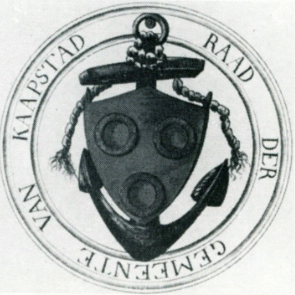
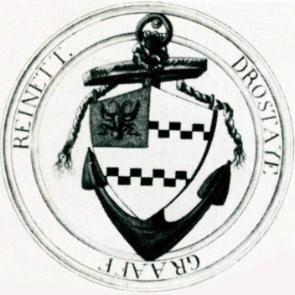
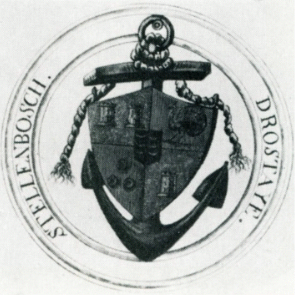
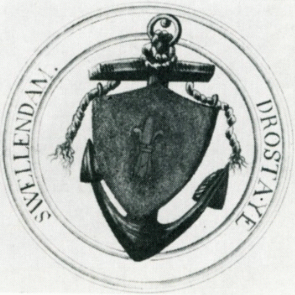
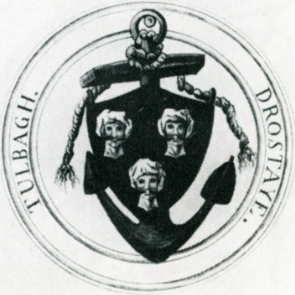
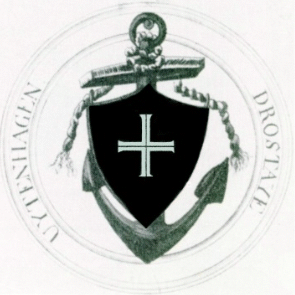
Commissioner-General De Mist also created an autonomous town council for Cape Town (the Raad der Gemeente Kaapstad, the first in the country) and granted arms to this body and to the five drostdijen. The pattern for these arms was a shield with an anchor as a single supporter, the shield in each case bearing the family arms of the founder or namesake of the town – the arms of Jan van Riebeeck for Cape Town, Simon van der Stel for Stellenbosch, Hendrik Swellengrebel for Swellendam, Cornelis van de Graaff for Graaff-Reinet, Ryk Tulbagh for Tulbagh, and De Mist himself for Uitenhage.
The anchor had long been a symbol of the Cape Colony – a symbolic virgin symbolising Hope, with an anchor representing the virtue she stood for, had been used as a symbol of the colony since the 17th century.
In 1827 Acting Governor Major-General Richard Bourke issued the Charter of Justice which abolished the position of landdrost, and created instead magistrates and civil commissioners. The roles of judicial official and administrator were still (usually) combined in one person, but in his judicial function the official was called a magistrate, while as an administrator he was civil commissioner. This duality existed in most of the districts/civil divisions of the Cape Colony, but in a few instances magisterial districts were created which were subdivisions of civil divisions. This applied especially in the Cape Peninsula, which formed a single division, but three magisterial districts: Cape Town, Wynberg and Simonstown.
When the first boards of municipal commissioners (later called municipal councils) were established in 1840, these boards (in the towns that had been drostdij seats) assumed the right to the arms of the respective drostdij.
In 1855 Sir Andries Stockenström steered the Divisional Councils Act through the Cape Parliament. It provided for the establishment of a council of rural administration in each civil division, with in each case the civil commissioner as chairman. This system was applied in all parts of the Cape Colony except the Transkeian Territories (see Transkei).
One Transkeian division, that of Umzimkulu in the far north-east, acquired a local roads board, which was regarded as being equivalent to a divisional council, but in the rest of Transkei, control was in the hands of magistrates and statutory tribal authorities.
Civil commissioners disappeared under the Union of South Africa, and the divisional councils then elected their own chairmen.
Divisional councils did not at first use coats of arms, but when they began adopting them the drostdij arms had already been in use by the respective municipalities for many years, and the divisional councils had to find new symbols.
In 1958 the Union Government announced that the term landdros was in future to be used as the Afrikaans equivalent of magistrate (the word magistraat had previously been used).
At the system’s height the Cape Province had 92 divisional councils (where the divisional name differs from that of the district seat, the principal town’s name is given in brackets):
Aberdeen, Albany (Grahamstown), Albert (Burgersdorp), Alexandria, Aliwal North, Barkly East, Barkly West, Bathurst, Beaufort West, Bedford, Bredasdorp, Britstown, Caledon, Calitzdorp, Calvinia, Cape, Carnarvon, Cathcart, Ceres, Clanwilliam, Colesberg, Cradock, De Aar, East Griqualand (Kokstad), East London, Elliot, Fort Beaufort, Fraserburg, George, Gordonia (Upington), Graaff-Reinet, Hanover, Hay (Griquatown), Heidelberg, Herbert (Douglas), Hopetown, Humansdorp, Indwe, Jansenville, Kenhardt, Kimberley, King William’s Town, Knysna, Komga, Kuruman, Ladismith, Lady Grey, Laingsburg, Loxton, Maclear, Mafeking, Malmesbury, Maraisburg (Hofmeyr), Middelburg, Molteno, Montagu, Mossel Bay, Murraysburg, Namaqualand (Springbok), Oudtshoorn, Paarl, Pearston, Philipstown, Piketberg, Port Elizabeth, Prieska, Prince Albert, Queenstown, Richmond, Riversdale, Robertson, Somerset East, Stellenbosch, Sterkstroom, Steynsburg, Steytlerville, Stutterheim, Sutherland, Swellendam, Tarka (Tarkastad), Tulbagh, Uitenhage, Uniondale, Vaalharts, Vanrhynsdorp, Venterstad, Victoria West, Vryburg, Williston, Willowmore, Wodehouse (Dordrecht) and Worcester.
The Cape Division was an exceptional part of this system, comprising by 1970 five magisterial districts (now including Bellville and Goodwood) and parts of the Stellenbosch and Malmesbury districts, nine municipalities and 17 local areas. The Cape Divisional Council was first constituted in 1855. By Act 33 of 1909 it became the Rural Council of the Cape Division, but by an ordinance of 1917 it reverted to its original name. It had wider powers than any of the other 91 divisional councils, and greater powers of taxation.
The East Griqualand Divisional Council became a branch office of the Natal Provincial Administration when this district was handed over to that province in 1976, following Transkeian independence, which separated it from the rest of the Cape Province.
In the 1970s the high cost of rural administration forced the Cape Provincial Administration to amalgamate some divisional councils, and in the Algoa Bay region the Dias Divisional Council came into being; in the vicinity of George, the Outeniqua Divisional Council, and in the Border area the Stormberg Divisional Council (based in Queenstown) and Divisional Council of Kaffraria (based in East London). The Kaffraria Division’s name recalls the Colony of British Kaffraria, which had had a separate existence from 1847 to 1866; however, while it included the East London district, the colony did not include East London itself.
In the 1980s a new system of regional services councils was introduced. Such RSCs saw further consolidation of existing divisional bodies.
The reorganisation of local government in 1995 (following the election of the first post-apartheid Parliament in 1994) saw the introduction of district councils, which took the process of amalgamation a step further.
The second post-apartheid reorganisation, implemented in 2000, resulted in a radical change under which municipal and district authority were combined for the first time since 1840. It seems appropriate to end this history here, and to consider the post-2000 system separately.
The divisional council system remained unique to the Cape, and had no equivalent in the other three states that joined the Union in 1910.
The Republiek Natalia organised three districts in 1840 – Port Natal, Pietermaritzburg and Winburg – each with a landdrost and heemraden, but this system fell away in 1841 with the annexation of this state as the Colony of Natal. It would seem as if the office of heemraad fell away at Winburg when that town was annexed as part of the Orange River Sovereignty.
When in the 1850s the Oranje Vrij Staat and Zuid Afrikaansche Republiek came into being, these states appointed a landdrost in each district, but not heemraden. When these states were annexed by Britain during the South African War (as the Orange River Colony and the Transvaal Colony) the landdrosts were replaced by magistrates, who functioned without the assistance of any council. This situation continued after Union (1910) in the Orange Free State Province and Transvaal Province.
The only authority created in the Transvaal Province that could be seen as being equivalent to divisional councils was the Peri-Urban Areas Board, which was responsible for administering (chiefly white-occupied) townships and densely settled rural areas outside the proclaimed boundaries of the existing municipalities.
The colony and province of Natal similarly had magistrates but no other district authority.
